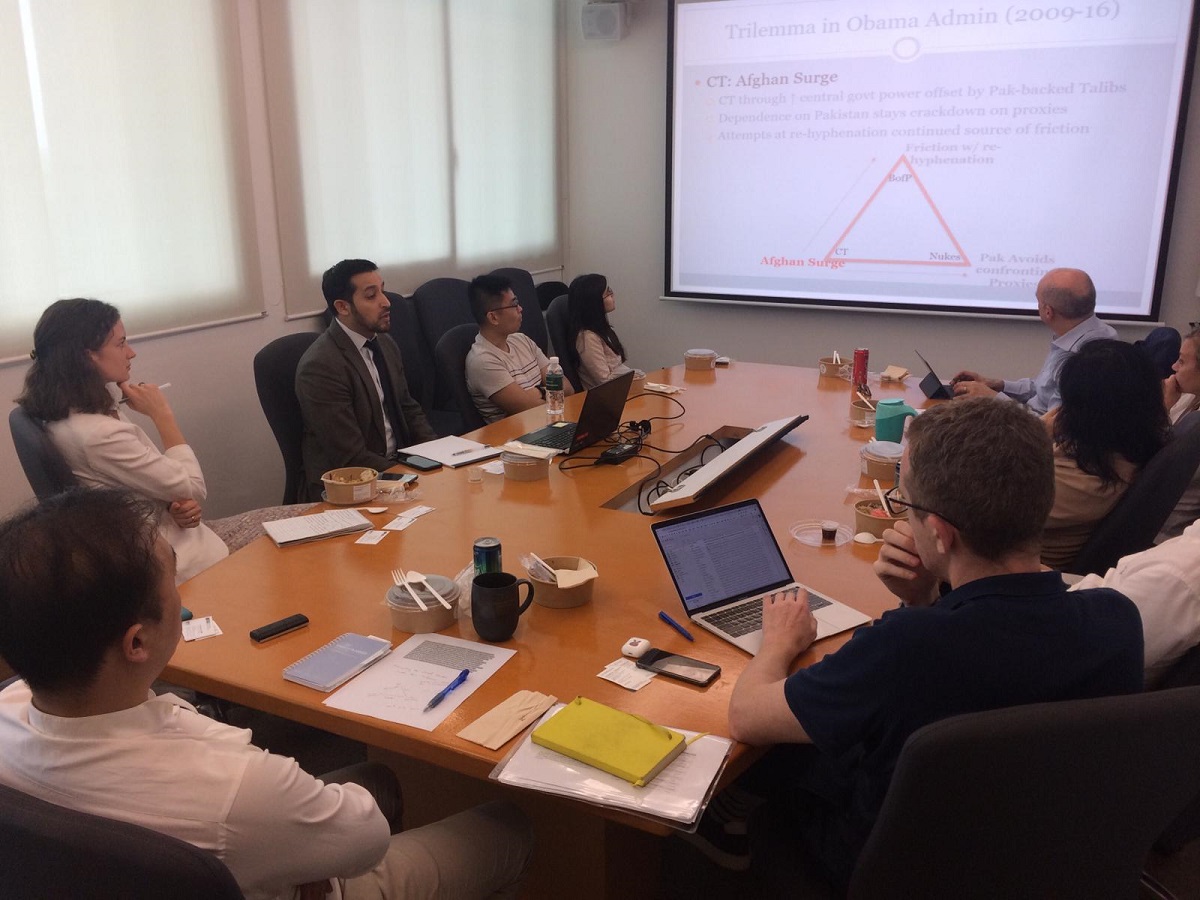
On January 21, 2020, Dr. Sameer Lalwani, Senior Fellow and Director of the South Asia Program at the Stimson Center presented on the topic of Navigating the United States’ South Asia Trilemma. The trilemma stems from the fact that the US has multiple conflicting objectives in South Asia, which can be roughly deduced as: 1. The balance of power in Eurasia, 2. Nuclear stability and non-proliferation in South Asia, and 3. Counter-terrorism especially in Afghanistan and Pakistan. These have been the long-standing objectives of US foreign policies in South Asia, but as the US tries to address all three concerns, it came to Dr. Lalwani’s attention that there are in fact some tensions between the three objectives and this may have implications for policy-making.
As mentioned, the juxtaposition of these three objectives has not been a recent event. During the G.W. Bush Administration, the September 11 attach led to the “War on Terror” and the Afghani War of 2001. The standoff between India and Pakistan between 2001 and 2002, which almost triggered a nuclear war between the two, forced the US to pay more attention to the India-Pakistan rivalry. On top of that, the EP-3 Crisis between the US and China in April 2001 intensified the great power competition between the two countries, and made the US to think India as a critical balancer of power in Asia. Likewise, during the Obama Administration, we also see a similar juxtaposition of three policies: The Afghani Surge of 2009 enhanced US commitment to the “War on Terror”. The possibility that the Taliban may be able to obtain nuclear weapons in Pakistan once again made the US concern about nuclear security in the region, while in the same year, the visit to the US by then Indian Prime Minister Manmohan Singh became the first state visit that Obama hosted as the president of the US, which paved a better foundation for a more strategic relationship between the US and India.
In the fulfillment of the three US objectives in South Asia, India is important both in the areas of balance of power in Asia and nuclear security; Pakistan is important in counter-terrorism and nuclear security; while Afghanistan is important in counter-terrorism and (potentially) the balance of power in Asia. The challenge, however, is the “trilemma”, that is, when the US tries to advance in one of these three objectives, it has direct trade-offs with the other two objectives. In the end, none of the three objectives could progress well, as they negatively interact with one another. While trade-offs are not a new phenomenon, but the curious thing is that, the successive US administrations have pursued all objectives without articulating or appreciating the possible trade-offs and how they could unfold. For example, if the US tries to enhance its policies on the balance of power in Asia, it is very likely that the pursuit of such policies may jeopardize the other objectives of counter-terrorism and nuclear stability in the region.
According to Dr. Lalwani, such trade-offs usually care caused by either external reaction mechanisms or internal limitations. For external reactions, when the US advances in one objective, the external custodians and interest groups in other objectives may question US commitment in their own objectives. Hence they may slow down or even halt their cooperation with the US in these areas. On top of that, driven by fear of US inactions, the custodians of other objectives may act on their own and create counter-pressure for the US. As for limitations on internal resources, it is more bureaucratic and mainly rise from constrains in diplomatic commitments, limited budget, and the lack or transfer of functional expertise or skills.
In order to manage this trilemma, Dr. Lalwani argues that since it is impossible to advance all three objectives all at the same time, then it is necessary to prioritize the objectives. The most beneficial hierarchy would be to prioritize the balance of power in Asia and Indo-Pacific first, followed by nuclear security in South Asia, and then counter-terrorism. Therefore, it is a priority for the US to strengthen its relationship with India so that the latter can serve as an efficient balancer of power in the region. The second management strategy is to help India in mitigating its security dilemma such as by promoting its Anti-Access/Area Denial (A2/AD) abilities without providing it with strategic weapons or by accepting India’s arms purchases from Russia. At the same time, the US must maintain its relationship with Pakistan so as to prevent it from fully falling into China’s orbit. Finally, the US should continue to cooperate with Afghanistan and seek to bring China into this cooperation.
During the Q&A, it was suggested by members of the audience that Dr. Lalwani could better define and explain the effects of “distrust mechanism” and “fear mechanism”, as if the latter is provoked, then it may lead the custodians to take more risky choices, while in the case of the former, the US could simply enhance the trust between the dyad. Dr. Lalwani stated that the “distrust mechanism” may only slow down cooperation, but “fear mechanism” shifts direction of cooperation.
Also, it was questioned if some “trade-offs”, such as worsening India-Pakistan relationship, might be a natural effect of these two actors and their respective interpretations of US actions, and not exactly caused by US advancements of its objectives per se. It was also pointed out by members of the audience that usually a trilemma is defined as the achievement of any two goals will lead to the loss of the third, but in this case, it is an “extreme trilemma” whereby the achievement of any one will cause the actor to lose the other two. It was also pointed out that despite US hegemonic role in the world, but smaller players in South Asia still have leverages in the region against the US.